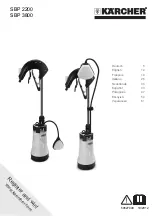
Page 10
504954M 08/06
5. Remove the pressure tap valve cores from the
HPXA16 unit’s service valves. Connect an HCFC−22
cylinder with clean refrigerant to the vapor service
valve. Connect the HCFC−22 gauge set to the liquid
line valve and connect a recovery machine with an
empty recovery tank to the gauge set.
6. Set the recovery machine for liquid recovery and start
the recovery machine. Open the gauge set valves to
allow the recovery machine to pull a vacuum on the ex-
isting system line set and indoor coil.
7. Invert the cylinder of clean HCFC−22 and open its
valve to allow liquid refrigerant to flow into the system
through the vapor line valve. Allow the refrigerant to
pass from the cylinder and through the line set and the
indoor coil before it enters the recovery machine.
8. After all of the liquid refrigerant has been recovered,
switch the recovery machine to vapor recovery so that
all of the HCFC−22 vapor is recovered.
NOTE − A single system flush should remove all of the
mineral oil from the existing refrigerant lines and in-
door coil. A second flushing may be done (using clean
refrigerant) if insufficient amounts of mineral oil were
removed during the first flush.
Each time the system
is flushed, you must allow the recovery machine
to pull a vacuum on the system at the end of the
procedure.
9. Close the valve on the inverted HCFC−22 drum and
the gauge set valves. Pump the remaining refrigerant
out of the recovery machine and turn the machine off.
10. Use dry nitrogen to break the vacuum on the refriger-
ant lines and indoor coil before removing the recovery
machine, gauges and HCFC−22 refrigerant drum. Re-
install pressure tap valve cores into HPXA16 service
valves.
11. Install the provided check expansion valve (approved
for use with HFC−410A refrigerant) in the liquid line at
the indoor coil.
Manifold Gauge Set
Manifold gauge sets used with systems charged with
HFC−410A refrigerant must be capable of handling the
higher system operating pressures. The gauges should be
rated for use with pressures of 0 − 800 on the high side and
a low side of 30" vacuum to 250 psi with dampened speed
to 500 psi. Gauge hoses must be rated for use at up to 800
psi of pressure with a 4000 psi burst rating.
Service Valves
The liquid line and vapor line service valves (figures 15 and
16) and gauge ports are used for leak testing, evacuating,
charging, and checking charge. See table for torque requi-
rements.
Front-Seated Liquid Line Service Valve
SERVICE
PORT
(Valve Shown Open)
insert hex wrench here
To outdoor coil
STEM
CAP
Service port Is open to
line set when valve is
closed (front seated)
Figure 15
To
indoor coil
To outdoor coil
STEM
CAP
(Valve Shown Closed)
Insert hex wrench here
CAP
To
indoor coil
SERVICE
PORT
CAP
SERVICE PORT
BALL (SHOWN
CLOSED)
STEM
CAP
SCHRADER VALVE
SERVICE
PORT CAP
TO
INDOOR
COIL
TO
OUTDOOR
COIL
STEM
USE ADJUSTABLE WRENCH
TO OPEN: ROTATE STEM
COUNTER-CLOCKWISE 90°.
TO CLOSE: ROTATE STEM
CLOCKWISE 90°.
Ball−Type Vapor Valve (Valve Closed)
Figure 16
Each valve is equipped with a service port which has a fac-
tory−installed Schrader valve. A service port cap protects
the Schrader valve from contamination and serves as the
primary leak seal.










































